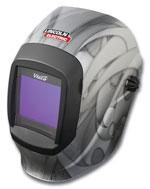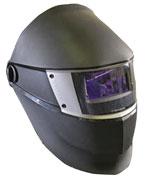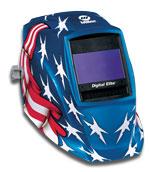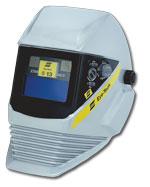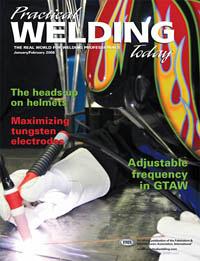- FMA
- The Fabricator
- FABTECH
- Canadian Metalworking
Categories
- Additive Manufacturing
- Aluminum Welding
- Arc Welding
- Assembly and Joining
- Automation and Robotics
- Bending and Forming
- Consumables
- Cutting and Weld Prep
- Electric Vehicles
- En Español
- Finishing
- Hydroforming
- Laser Cutting
- Laser Welding
- Machining
- Manufacturing Software
- Materials Handling
- Metals/Materials
- Oxyfuel Cutting
- Plasma Cutting
- Power Tools
- Punching and Other Holemaking
- Roll Forming
- Safety
- Sawing
- Shearing
- Shop Management
- Testing and Measuring
- Tube and Pipe Fabrication
- Tube and Pipe Production
- Waterjet Cutting
Industry Directory
Webcasts
Podcasts
FAB 40
Advertise
Subscribe
Account Login
Search
Welding helmets in view
Five welding helmets, five sets of capabilities
Choosing the right welding helmet is not as easy as it once was. Technology advances have turned these once simple pieces of protective equipment into smart, lightweight safety devices that, in some cases, can adapt their settings automatically to accommodate specific applications.
Welders who perform a variety of welding processes, as well as pre- and postwelding operations, may need a helmet that can provide them with many layers of protection. Conversely, welders who specialize in one particular process may not need a helmet quite so complex.
By researching welding helmets, welders will be better prepared to choose a helmet that will give them the level of protection and the features that they need. Failure to do so could lead to purchasing a helmet that is too pricey or that doesn't provide the welder with an appropriate level of protection.
Each of the following welding helmets provides different features and levels of protection. Bear in mind that these are only five of the many models available.
Lincoln Electric's VISTA® autodarkening helmets include a full-featured cartridge; four arc sensors; and variable levels of shade, sensitivity, and delay.
Available in three models—the 1000, 2000, and 3000—each helmet meets ANSI Z87.1 and CSA Z94.3 standards and provides the welder with the option to choose the view size right for him. Shade is adjustable from 9 to 13.
Variable sensitivity includes a grinding mode, in which the lens fixes the shade at the light state of shade 3. A GTAW mode assists the helmet in detecting the arc in low-amperage welding applications, as low as 5 amps. Variable delay protects operators from the bright light of slow-cooling weld nuggets during high-amperage welding.
Four independent sensors help to ensure the autodarkening lens reliably and safely darkens in any application, moving from light to dark in 1/10,000 second. The helmets include a cover/spatter plate that can be changed in seconds from the front of the helmet. Welders can custom-fit the helmet with the Push-N-Turn™ headgear and the patent-pending tilt mechanism, which adjusts the viewing angle and helmet down stop.
The Speedglas™ Super Light (SL) welding helmet and autodarkening filter (ADF) from 3M is 25 percent lighter than other Speedglas helmets.
The new SL features a lighter ADF by using a new liquid crystal cell design and PPA, a strong, lightweight material that protects against spatter and sparks. The helmet offers a light-state shade of 3 and dark shades of 8 to 12, which makes it suitable for all arc welding processes.
A new motion detector automatically turns the filter on and off within 15 minutes of the last arc sensed or the last movement. ADF batteries are replaceable.
The four-position, back-and-forth adjustment headband design allows for a customized fit. The headband's hole pattern increases breathability and comfort and further reduces weight.
Digital Elite™ series autodarkening helmets from Miller Electric Mfg. Co. allow a welder to switch among four modes—welding, cutting, grinding, and X-mode—while retaining preferences for shade, sensitivity, and delay. The series provides protection in low-amperage GTAW applications 5 amps or less and on obstructed or hidden-cavity welds.
Welding shades are from 8 to 13; cutting shades are from 5 to 8; grinding shade is 3; and X-mode shades are from 8 to 13.
Four independent arc sensors respond in 1/20,000 second. An auto-off feature comes standard.
The X-mode electromagnetically senses the arc, providing protection against instances when an arc is present but the sensors are obstructed. It eliminates interference from sunlight and out-of-position welding angles such as those found in pipe welding.
ESAB Welding & Cutting Products' Eye-Tech 5-13 welding helmets operate on solar power, so there are no batteries to replace and no on/off switches.
The helmets are suitable for all welding applications, including oxy-gas, and allow for adjustment from shades 5 to 13. A grinding mode (shade 4) can be activated from the outside, and detection sensitivity can be adjusted.
Constructed of Zytel®, a lightweight, nonflammable material, the helmet provides a viewing area of 3.86 by 1.57 in. and an adjustable dark-to-light delay from 0.1 to 0.35 second (fast) to 0.3 to 0.6 second (slow). Full UV and IR protection is provided up to shade 15.
Jackson Safety Inc. offers the BOSS™ EQC welding helmet.
The helmet provides a viewing area of 13 sq. in.; a variable shade from 9 to 12; and modes for welding, cutting, and grinding. These plus sensitivity and delay adjustments give the welder the ability to adjust the helmet to a specific application.
Intellisense™ technology is ideal for low-amperage GTAW applications. A built-in mag lens adapter provides for simple magnification when required.
About the Publication
subscribe now

The Welder, formerly known as Practical Welding Today, is a showcase of the real people who make the products we use and work with every day. This magazine has served the welding community in North America well for more than 20 years.
start your free subscription- Stay connected from anywhere

Easily access valuable industry resources now with full access to the digital edition of The Fabricator.

Easily access valuable industry resources now with full access to the digital edition of The Welder.

Easily access valuable industry resources now with full access to the digital edition of The Tube and Pipe Journal.
- Podcasting
- Podcast:
- The Fabricator Podcast
- Published:
- 04/16/2024
- Running Time:
- 63:29
In this episode of The Fabricator Podcast, Caleb Chamberlain, co-founder and CEO of OSH Cut, discusses his company’s...
- Trending Articles
Sheffield Forgemasters makes global leap in welding technology

Welding student from Utah to represent the U.S. at WorldSkills 2024

Lincoln Electric announces executive appointments

Lincoln Electric acquires RedViking

Engine-driven welding machines include integrated air compressors

- Industry Events
16th Annual Safety Conference
- April 30 - May 1, 2024
- Elgin,
Pipe and Tube Conference
- May 21 - 22, 2024
- Omaha, NE
World-Class Roll Forming Workshop
- June 5 - 6, 2024
- Louisville, KY
Advanced Laser Application Workshop
- June 25 - 27, 2024
- Novi, MI
























